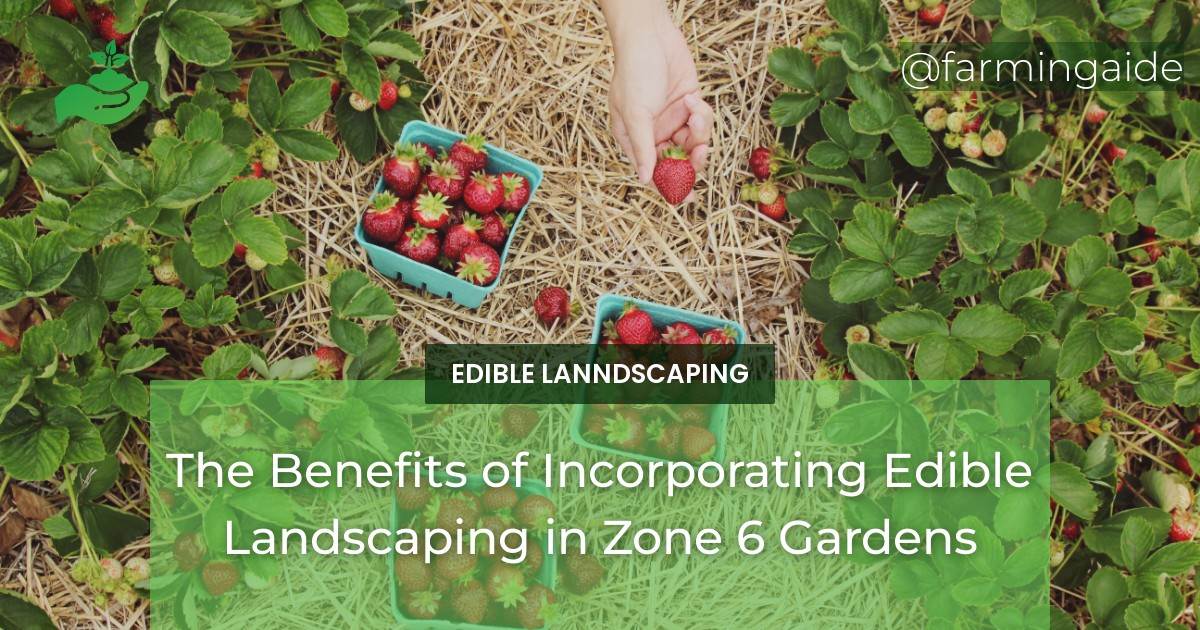Edible landscaping is a growing trend in the world of gardening, and for good reason. Not only does it provide a beautiful and functional landscape, but it also allows for the production of fresh, healthy food right in your own backyard. And for those living in zone 6, incorporating edible landscaping into your garden can have even more benefits. In this article, we will explore the benefits of incorporating edible landscaping in zone 6 gardens and provide tips and techniques for successful implementation. So let’s dig in and discover how you can create a thriving edible landscape in your zone 6 garden.
How Can Edible Landscaping in Zone 6 Gardens Contribute to a Sustainable Ecosystem?
Edible forest gardens design in Zone 6 gardens can greatly contribute to a sustainable ecosystem. By incorporating a variety of fruit and nut trees, along with edible plants and shrubs, these gardens help to support local biodiversity, reduce food miles, and promote a more sustainable, self-sufficient way of living.
Introduction to Edible Landscaping and Zone 6 Gardens
Edible landscaping is the practice of incorporating edible plants into your landscape design. This can include fruits, vegetables, herbs, and even edible flowers. Not only does it provide a beautiful and functional landscape, but it also allows for the production of fresh, healthy food right in your own backyard. And for those living in zone 6, incorporating edible landscaping into your garden can have even more benefits.
Zone 6 gardens are characterized by their unique climate conditions, which can include cold winters and hot summers. This can make it challenging to grow certain plants, but with the right techniques and plant selection, a thriving edible landscape can still be achieved.
Plant Selection for Zone 6 Gardens
When it comes to edible landscaping in zone 6, plant selection is key. It’s important to choose plants that are well-suited to the climate and can thrive in the unique conditions of zone 6. Some examples of vegetables, fruits, and herbs that do well in zone 6 include:
- Tomatoes
- Peppers
- Squash
- Blueberries
- Raspberries
- Strawberries
- Basil
- Thyme
- Rosemary
It’s also important to consider the different areas of your garden when selecting plants. Some plants may do better in sunny spots, while others may thrive in shady areas. Be sure to research the specific needs of each plant and plan accordingly.
Companion Planting in Zone 6 Gardens
Companion planting is the practice of planting certain plants together for mutual benefit. In zone 6 gardens, this can be especially beneficial as it can improve soil health and pest control. Some examples of plants that make good companions for each other in zone 6 gardens include:
- Tomatoes and basil
- Cucumbers and radishes
- Marigolds and beans
Companion planting can also help to attract beneficial insects and deter pests, creating a more balanced ecosystem in your garden.
ALSO READ
Maximizing Climate Conditions for Edible Landscaping in Zone 6
Zone 6’s climate conditions can actually be used to your advantage when it comes to edible landscaping. For example, the cold winters can be utilized to extend the growing season by planting cold-hardy crops such as kale, spinach, and Brussels sprouts. Additionally, utilizing microclimates in your garden can help certain plants thrive. For example, planting heat-loving plants in a south-facing area can provide them with the warmth they need to grow.
Soil Management and Composting for Zone 6 Gardens
Healthy soil is essential for successful edible landscaping in zone 6. It’s important to regularly test and amend your soil to ensure it has the proper nutrients for your plants. Composting is a great way to improve soil quality and can also help to reduce waste. Some tips for dealing with common soil issues in zone 6 include:
- For heavy clay soil, add organic matter such as compost or aged manure to improve drainage.
- For sandy soil, add compost or mulch to help retain moisture and nutrients.
- For acidic soil, add lime to raise the pH level.
Pest and Disease Control in Zone 6 Gardens
Like any garden, zone 6 gardens can face challenges with pests and diseases. However, there are natural and organic methods for controlling these issues. Some tips for pest and disease control in edible landscaping include:
- Encouraging beneficial insects by planting flowers and herbs that attract them.
- Using natural pest deterrents such as neem oil or garlic spray.
- Practicing good garden hygiene by removing diseased plants and debris.
Early detection and prevention are also key in maintaining a healthy garden. Regularly inspecting your plants and addressing any issues early on can help prevent larger problems down the road.
Sustainable Gardening Practices for Zone 6 Gardens
Sustainable gardening is not only beneficial for the environment, but it can also help to create a more resilient garden. Some tips for sustainable gardening in zone 6 include:
- Conserving water by using drip irrigation or collecting rainwater.
- Using energy-efficient tools and techniques, such as hand tools and solar-powered lights.
- Utilizing mulch to help retain moisture and suppress weeds.
Seasonal Planning and Crop Rotation in Zone 6 Gardens
Seasonal planning and crop rotation are important for maintaining a healthy and productive garden in zone 6. Some benefits of crop rotation include:
- Preventing nutrient depletion in the soil.
- Reducing the risk of pests and diseases.
- Maximizing yield by planting crops that complement each other.
Be sure to plan out your garden for each season and rotate crops accordingly to reap the benefits.
Conclusion
Incorporating edible landscaping into your zone 6 garden can have numerous benefits, from providing fresh, healthy food to creating a beautiful and functional landscape. By selecting appropriate plants, utilizing companion planting and sustainable practices, and maximizing the unique climate conditions of zone 6, you can create a thriving edible landscape in your own backyard. So get out there and start planning your zone 6 garden today!
RELATED ARTICLES:


